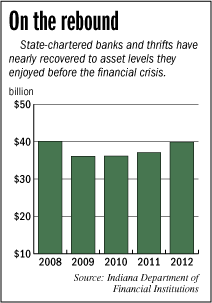Subscriber Benefit
As a subscriber you can listen to articles at work, in the car, or while you work out. Subscribe NowIndiana’s 92 state-chartered banks and thrifts, working through a pile of troubled loans since the economy nosedived five years ago, appear nearly to have regained their footing.
But observers say state-chartered banks, particularly many of the smaller ones—face ongoing challenges, from low interest rates to federal regulations to access to capital.
Total assets—what these institutions held in the way of loan value and investments—rose 7.7 percent in 2012, to $39.9 billion. That’s within a few whiskers of pre-crash assets of $40.1 billion, in 2008, according to the annual financial report of the Indiana Department of Financial Institutions.
Total assets of state-charted banks fell to $36.1 billion in 2009. That year, a little more than 21 percent of Indiana financial institutions were unprofitable—compared with 3.7 percent in 2012.
 Deposits, meanwhile, showed an 8-percent increase from 2011, to hit $2.5 billion last year.
Deposits, meanwhile, showed an 8-percent increase from 2011, to hit $2.5 billion last year.
“Due mainly to the recovery from the recession, improvement is noted in the performance and condition of Indiana’s financial institutions as reflected in most financial categories and ratios” from 2011 to 2012, the department said in its report.
The economy is still soft, but lending has picked up in auto and residential mortgages, said John C. Reed, executive vice president of investment banking at David A. Noyes & Co. in Indianapolis.
“Bankers are now lending. They were spending their time as [bad loan] work-out officers” in the last four years, added Reed.
But low interest rates are making it difficult for banks to make money from loans, particularly for rural community banks, said Joe DeHaven, president and CEO of the Indiana Bankers Association. “That margin is just continuing to get squeezed.”
Many of the larger banks have other business lines and diverse sources of fee income to help offset the effects of lower margins, he noted.
Compounding the challenge is a new wave of banking regulation, including more than 10,000 pages of regulation under the Dodd-Frank Act, which, DeHaven said, “is just chewing these guys up.”
Many of the smaller banks also struggle to gain access to capital that the bigger banks can more easily raise by issuing new shares.
DeHaven said a number of rural banks, in particular, continue to struggle to attract a high-quality professional staff for the increasingly complicated and more highly regulated industry.
While Indiana has had only a few state-chartered banks fail in recent years, and although aggregate financial signs are improving, the industry here continues to consolidate. DeHaven remembers that in 1980 Indiana had about 600 Indiana-headquartered financial institutions—compared with about 100 today.
Some observers expect a new wave of mergers as small community bankers grow weary of the environment and decide it’s time to retire. Many larger banks have seen their shares rise, meaning the stock has given buyers a stronger currency to make acquisitions.
Reed points to success of banks such as Muncie-based First Merchants Corp., which earlier this year snapped up Munster-based CFS Bancorp and its Citizens Financial Bank, for $115 million in stock.
Last year, First Merchants bought the loans and deposits of the failed SCB of Shelbyville.
“I don’t think we’ll have an onslaught, but we’ll see some mergers and acquisitions,” said Reed, who brokered numerous deals in Indiana over the last three decades.
The average return on assets for state-chartered financial institutions in 2012 was 1.15 percent, up from 0.93 percent in 2011, said the Department of Financial Institutions. Return on assets is a measure of operational efficiency.•
Please enable JavaScript to view this content.
